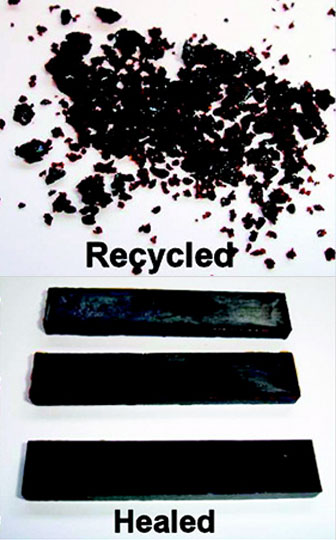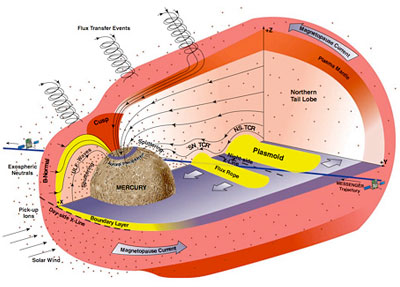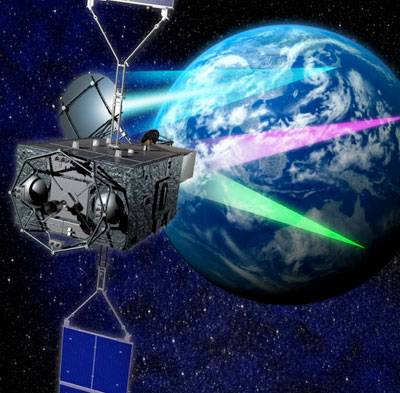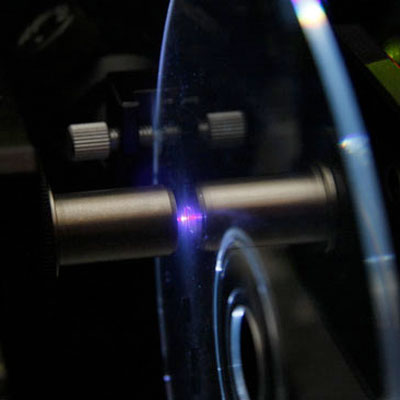 This week, Science Friday brings you self-mending plastics, magnetic twisters, space-based energy, self-propelling chemicals, and an exclusive look at the how Star Trek 2009 is impacting laboratory scientists. All this plus our gadget of the week: Holographic Storage Discs!
This week, Science Friday brings you self-mending plastics, magnetic twisters, space-based energy, self-propelling chemicals, and an exclusive look at the how Star Trek 2009 is impacting laboratory scientists. All this plus our gadget of the week: Holographic Storage Discs!
Self-Mending Plastics for Tough Recyclables
Most of the plastics that are recyclable today — water bottles and grocery bags, for instance — are what are called thermoplastics. They are polymers that can be melted down and molded into something else. But, other plastics known as thermoset resins, which make up things like circuit boards, electrical insulation, and epoxy glue, aren’t so easy to recycle. When these resins are heated, they decompose and tend to end up as waste. Scientists have now created thermoset resins that, rather than decompose, repair themselves when heated. The researchers demonstrated that the material can be shredded, melted and remolded at least seven times with no loss of mechanical properties.

Like magic!
Magnetic Twisters on Mercury
New findings from the MESSENGER spacecraft in orbit around Mercury have indicated that the supersonic wind from the sun creates never before seen magnetic “twisters” that dance across Mercury’s magnetic field and occasionally touch down on the surface. The invisible structures, made of high-energy electrons, kick up material from the planet’s surface and send it flying into the atmosphere. The solar wind affects Earth, too, and we see evidence of that in the spectacular aurorae that light up our northern and southern skies. Understanding these magnetic twisters on Mercury can help scientists to understand more about “space weather” and how it affects us here at home.

Electro-magnetic madness!
Space-Based Solar Energy
Like something straight out of a science fiction novel, renewable energy company SolarEn plans to launch solar panel arrays into space to capture the rawest form of solar energy and send it back down to earth. The company plans to convert the captured solar energy into radio frequencies that would then be sent to the surface. Although not exactly a new concept, sending solar energy technology into space this time around has a lot more promise. Plans by the US Government to achieve the same thing have been undertaken by NASA and the Pentagon as early as the 1960’s. Critics cite the costly nature of sending the satellites into space; but SolarEn ensures that their technology is commercially viable unlike any previous endeavors trying to achieve the same thing.

Collecting energy from the sun and beaming it down to Earth
Self-Propelling Chemical Created by Japanese Scientists
A group of Japanese roboticists at Waseda University, have created a chemical gel capable of independent motion, similar to that of a caterpillar. Using a process that combines polymers, the material not only moves on its own, but also can change colors and can be used to perform calculations. According to the scientists involved in the project the morphable material could even one day be used as components of a future robot, thus making the notion of the incredibly scary Terminator T-1000 a real possibility. Check out the video below!
TrekMovie EXCLUSIVE: Effects of Star Trek 2009 on the Nerd Psyche
Scientists such as myself have been noticing a distinct paradigm shift in the behavior of our fellow laboratory-inhabitants. Over the past month, experimentalists, modelers, and theoreticians have been in an ever-increasing state of elation. Normally prone to a state which mirrors the dinginess, gloominess, and lack of natural light that epitomizes “The Lab”, scientists have been described as of late as “chipper, good-natured, and generally productive”. The amount of elation in the subjects is directly proportional to the Star Trek 2009 propaganda now littering their walls, bulletin boards, and desktop wallpapers (See Fig. 1). If you or anyone you know is experiences these symptoms, don’t panic! Unless, of course, your colleagues begin citing Zefram Cochrane or Noonien Soong in journal articles. If that happens, get them to the local theater on or shortly after May 8th.

Figure 1
Gadget of the Week: GE’s 500GB Holographic Storage Discs
Yep, you read right: holograms! Like something you might see in the holodeck arch, or inside an engineering console, GE has developed micro-holographic disc that’s the same size as present-day CD, DVD and Blu-ray discs. Instead of the two-dimensional surfaces used for Blu-ray’s 50GB, holographic storage uses three dimensions to store digital data. These discs can store 500GB of data by using holographic light patterns to densely pack three-dimensional data. While still in the developmental phase at this point, industry experts are hopeful that it could become the next form of low-cost storage for consumers.

Holostorage!
Science Quickies
Not enough science for you? Here’s a warp-speed look at some more science tid-bits that are worth a look.
- Google Earth aids in yet another discovery, this time in early African mammal fossils
- Rogue black holes roaming the galaxy
- First lunar greenhouses planned for 2012
- Orion spacecraft gets first sea trials

Interesting stuff!
Simply amazing stuff here
Holographic disks have been in development for quite a long time now, nice to finally see a “working” thing. Let’s just hope those will be commercially available soon enough…
At last I can back up my freakin family photo/video collection on one disc
Really cool stuff this week! I can’t wait til all this stuff becomes commonplace!
DAMN! Holodiscs are going to be real…surely I need a 500Gb Holodisc to make a backup of my private datas *gg*
Great, now I have to go out and buy TOS on a single holodisk.
A Nurrr, of course we should be putting solar panels in space. Duhhing! Think of all the solar energy you can collect just with panels on the Earth surface, and then consider that the Earth only catches a tiny amount of the total sunlight that the sun shoots out in all directions, all of the time…
Man. The sooner we get a Dyson Sphere cranking, the better.
Holographic data storage has been in the lab for some time, but far to expensive to market.
what sets this apart is the use of bluray drive parts and a plastic CD like disk that reduce the cost of the drive low enough to actually put on the market.
Arrghh … more data storage … more chances to lose all of my data in one place …
#10 – easier to create 30 copies of ONE disc though, isn’t it?
One nitpik: MESSENGER isn’t in orbit around Mercury yet. It’s still in solar orbit, losing speed to do so, with at least one more close encounter later this year. Off the top of my head, I think it goes into Mercurian orbit in 2011.
Concerning the “walking gel”: “For all the good it’ll do you. It’s a fancy name, but how will something that looks like a drop of jelly make this thing work? You’ll need microgears and a pulley that does what a muscle does.”
We are gods in our infancy.
How about that Mercury news? As far as I’m concerned, that’s a dead planet (don’t start quotin’ Khan now xD).
A friend of mine has a holodisc actually. He showed me on webcam. They’re mostly transparent but have this nice glow under good lighting conditions. He’s lucky though, one of his friends is a developer in holodisc technology, so none for me. Just as well too, a reader/writer for one of those is looking to be around 9000 dollars at present
13. Captain Dunsel: “Concerning the “walking gel”: “For all the good it’ll do you. It’s a fancy name, but how will something that looks like a drop of jelly make this thing work? You’ll need microgears and a pulley that does what a muscle does.””
Not sure if you are quoting some other source, but this is 18th century thinking. How does a muscle do what it does without gears and pulleys?
looks like an iso-linear chip from TNG…they could probably be hardened to withstand EMP’s and other magnetic anomalies, especially the ones associated with space…talk about the possibilities!
Damn, just when I was starting to get on board with blu-ray now the next format rears it’s head. I think I’m going to stop buying movies all together. Go the pay per view route.
As always, AWESOME!~ BY FAR my favorite part of this site! Never fails to educate, entertain, enlighten, and inform me like no one else can!
My friend’s three year old child saw a Star Trek movie promo and started crying. Turned out he thought the little cloth pieces taped to the uniforms were the ears of the pointed ear guys torn off as the rest of the cast had ears trimmed to look human. Ah, to be a child again!
Reply to :”18. captainedd – May 1, 2009
looks like an iso-linear chip from TNG…they could probably be hardened to withstand EMP’s and other magnetic anomalies, especially the ones associated with space…talk about the possibilities!”
It would not need to be fortified. it is merely light that inputs/outputs data on to them, same as cds.
magnetism would have no effect. as for radiation… Shouldn’t affect it … but might in extreame cases. (ie you’d be more worried about your loss of life than loss of data.)
unless i’ve misunderstood something about the tech. (unlikely :-) )
17 – “Not sure if you are quoting some other source…”
Um, yes. I was quoting from Scotty in the TOS episode “Return to Tomorrow”.
Are you SURE you’re Not Herbert? (grin)
Ugh! You got me Capt. Dunsel. I suspected as much though… I guess I must have blocked out Scotty being so short sighted.
Comprehend its workings though Scott may not, the android form will surpass his Human strength and agility by 100%.
Let me buy you a pint next time we meet up at starbase… ;-)
IanH – As long as it’s green…